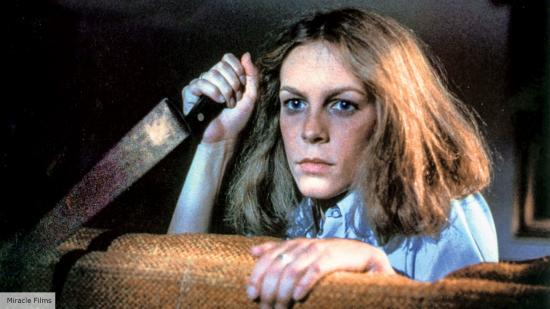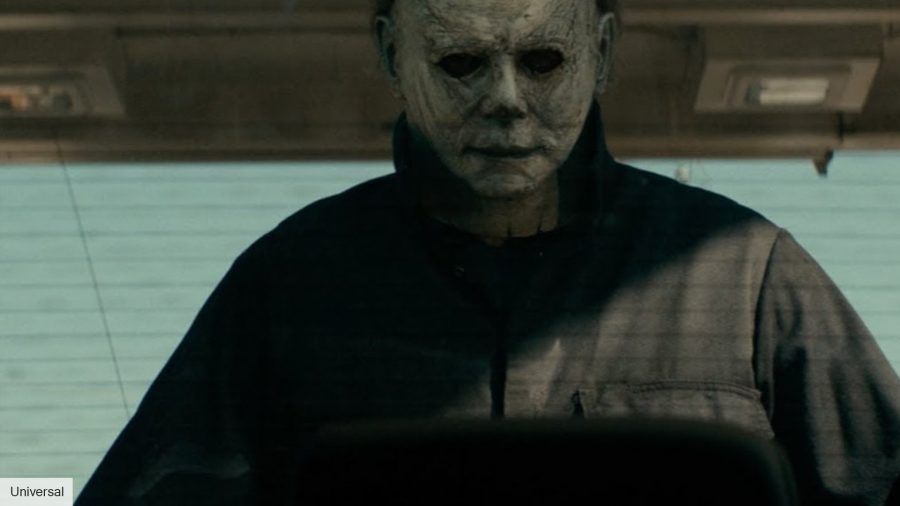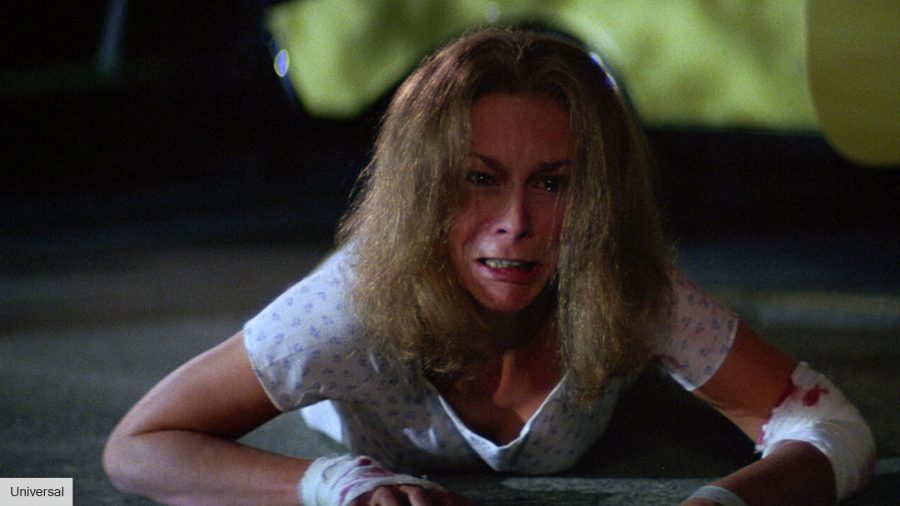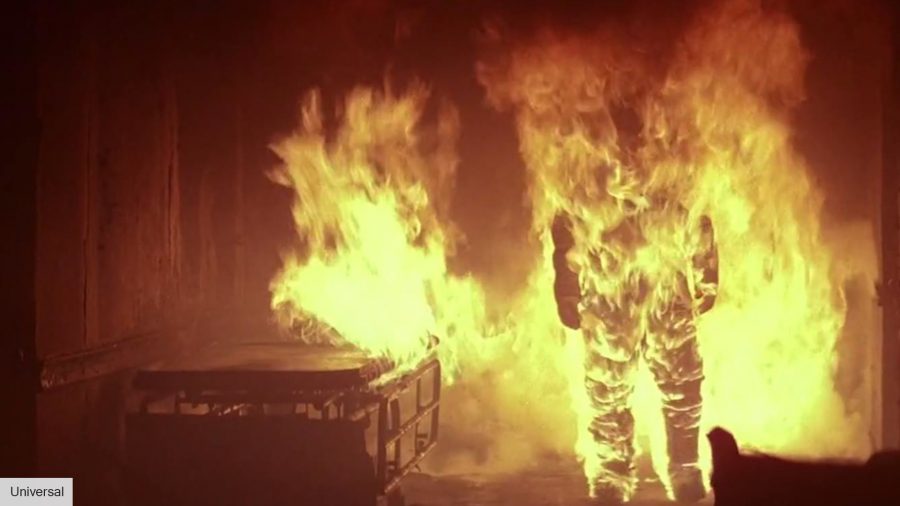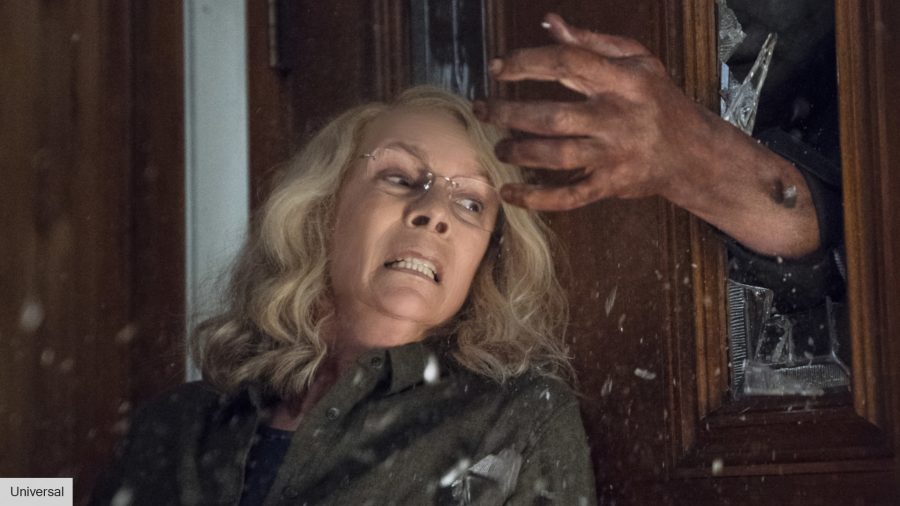Halloween (2018) officially changed the scary franchise by retconning all the sequels in the series, giving Michael Myers a fresh follow up – but was that a good idea? Yes, yes it was. Here we go through all the reasons why David Gordon Green’s reboot helped set the franchise back on course, as well as examine all the mistakes from the ‘80s movie, Halloween II, that it corrected by wiping it from the current Halloween canon.
In 1978 John Carpenter gifted the world with one of the best horror movies of all time, Halloween. The film introduced us to Michael Myers, a masked serial killer who started his murder spree at the age of 6when he killed his sister. Fans would later see the rubber-faced killer become a slasher icon as he stalked the citizens of Haddonfield and went head to head with high schooler Laurie Strode (Jamie Lee Curtis) for the first time. However, since the iconic thriller, there have been 11 more Halloween movies, four timelines, and a messy amount of Myers’ lore that needed fixing – cue Halloween (2018).
The latest Halloween timeline comes from David Gordon Green and Blumhouse Productions, who decided to make a new direct sequel to John Carpenter’s original movie. Green’s Halloween (2018) is set 40 years after the events of the 1978 film, where Michael escapes from an institution and goes out on the hunt once again, facing a now wiser Laurie who has been preparing for his return with plenty of firepower. The movie shocked the world by becoming the highest-grossing slasher on record, beating Wes Craven’s Scream. As previously mentioned, it also made all the other sequels in the Halloween franchise non-canon, as it effectively replaced Halloween II.
All the alternate Halloween timelines that you can latch onto (apart from Rob Zombie’s standalone remakes) include Halloween II, and therefore will always suffer from narrative failings. The ‘80s movie needed to be erased from the canon for the franchise to flourish. Before any long time Myers fans or Halloween H20 lovers denounce this article, please put down your kitchen knives and give me a chance to explain.
At the end of the first film, we saw Dr Loomis shoot Michael, who then fell off a balcony; however, when Loomis went to check for the body, Michael was nowhere to be seen. Halloween II, directed by Rick Rosenthal (Bad Boys), happens on the same night as the events from Carpenter’s 1978 original, making it a direct sequel. Until David Gordon Green’s movie, if you decided to watch a Halloween timeline that didn’t include Sheri Moon Zombie, it was a film that you couldn’t miss.
Halloween II shows Laurie in a close to comatose state of shock and being rushed to Haddonfield’s hospital after her endeavour with Michael. However, Michael Myers being Michael Myers isn’t going to let her go that easy. While Dr Loomis and the police chase after the killer, Michael makes his way over to Laurie and soon leaves a couple of paramedics and nurses in body bags. Halloween II had the big reveal (which to this day I still hate) of Michael and Laurie being related. The film claims that Laurie is Michael’s sister and tries to give reason for his obsession with her, already straying away from what made Carpenter’s film so creepy.
Haunting timelines: The best ghost movies
The concept of being stalked and hunted simply due to a random encounter is terrifying. What makes Laurie’s and Michael’s relationship so scary in the original movie is that it is written as if it could happen to anyone. Laurie was unlucky enough to catch Michael’s eye after she dropped off a set of keys at his childhood home, and that is all it took for the murderer to focus on her death.
However, when Halloween II puts Laurie in the unrelatable position as Michael’s relative and part of his ‘legend’, it changed their relationship for good and bulldozed everything that made it so impactful in the first place. Every film that followed Halloween II had to keep that relative reveal in its script, stopping the franchise from reclaiming the spark from Carpenter’s original, and causing a slew of weird story tangents such as a psychic niece (we are looking at you, Jamie).
While Halloween (2018) does see Michael come after Laurie, specifically like in Halloween II, its story motivation feels more in the vein of Michael focusing on ‘getting the one that got away’, and as an act of revenge for his 40 years of imprisonment. While it doesn’t fully capture the same vibe as the 1978 movie, it does feel like a plausible next step in their dynamic, and is still miles better than a lazy reveal that sidesteps any meaningful character analysis like the “oh she’s his other sister” plot point from Halloween II. It also left the door open for Michael to perhaps one day move to a new central victim and potentially let the white-faced murderer regain that initial spooky atmosphere.
OK, this hot take may make a few horror fans mad but, I’m going to say it anyway. I think Halloween II is a bit of a mess (if you couldn’t tell already). The 1981 movie is often looked at fondly for its creative kills and fun moments – such as a car bursting into flames or Michael literally melting a nurse’s face off. But being a great slasher movie doesn’t immediately mean that Halloween II is a good sequel to Carpenter’s film.
Hunted down: The best monster movies
In terms of story, I’ll be frank, it is incredibly frustrating, especially in its rewriting of Laurie Strode’s character and its definitive ending, something Halloween (2018) thankfully fixed. We already touched on Laurie and Michaels dynamic, but Halloween II’s issues go deeper into the actual character writing itself. In Carpenter’s 1978 movie, Laurie was a proactive young woman who continuously fought against the killer and made sure the kids she was babysitting that night were safe.
She was established as a kick-ass, resourceful woman who responds to danger as a fighter. Laurie Strode was a standout character for that time period and helped pave the way in terms of strong female survivors in horror, being a beacon of power and, in a sense, a role model within the slasher sub-genre. Even when Dr Loomis came to assist her in Carpenter’s film, Laurie still downed Michael multiple times by herself, and she was never portrayed as your stereotypical damsel in distress.
Halloween II strips Laurie of all her strength under the guise of her being too traumatised to even speak, making her lose the sense of urgency she had in the original film. While on paper seeing a version of Laurie dealing with the immediate aftermath of Michael’s attack is full of narrative potential, Halloween II never explores that plotline and instead shows a character who is a one-note shaking husk of her former self. In the film, Laurie is constantly cowering in the hospital, must deal with an uncomfortably handsy paramedic who adopts a ‘protector’ role, and basically, she is reduced to a cliche helpless young girl who needs a man to protect her from the big bad Michael Myers.
Although she technically ‘kills’ (she doesn’t actually) Michael in Halloween II by shooting him in the eyes, it is Dr Loomis, who sets the hospital on fire, offing himself and Michael in the process, and is the true hero in the film. Halloween (2018) brings Laurie’s strength back. In Green’s new sequel that replaces Rosenthal’s, Laurie is also dealing with the trauma of that fateful night in the ‘70s, only 40 years later. We learn that she has been preparing herself and her family for the return of Michael to the point of obsession, where it has cost her a normal relationship with her daughter (Judy Greer) and granddaughter (Andi Matichak).
Never say die: The best zombie movies
Laurie’s trauma isn’t projected as a complete shutdown but is instead morphed into an assertive form of PTSD as she has spent her life constantly training and preparing for another run with the Bogeyman, which aligns with the kick-ass character we first met in Carpenter’s original movie. Halloween (2018)’s Laurie is also multifaceted, as its script dives into her relationships and personality change. She isn’t the smiley high school student in the ‘70s anymore, but a hardened warrior who is haunted by her past, and Halloween (2018) doesn’t skimp on the details on how she got to that mental place.
If the argument of Laurie isn’t enough to convince you that the franchise starting at Halloween II needed to be retconned, let’s talk about its ending and the tonal shift from Carpenter’s film. Halloween II’s ending sees Myers very clearly get shot, then set on fire – in short; he is pretty much dead. Every film that came after Halloween II had to explain this death plot point away, resulting in Michael being tied to some convoluted supernatural rituals and mythology. Halloween II pretty much ends the franchise. Anything that tries to follow it becomes a bit of a muddy mess as it has to work to explain the new rules of Myers and quickly contextualise a new version of events, instead of the ones we saw happen at the end of the 1981 film.
Now let’s look at the tone. Halloween 1978 is amazing because of its simple and creepy dynamic. Michael stalking Laurie and then hunting her in a house, popping out from the shadows of a place you’d presume to be safe, is what makes Halloween one of the best thriller movies of all time. Halloween II loses this focused dynamic just like it messes up Laurie and Michael’s relationship, as it becomes more focused on Dr Loomis chasing Michael, then on Michael hiding in plain sight and killing from the shadows. It is the same night, same characters, but Halloween II feels different as it hyper focuses on super creative kills instead of building on the original’s atmosphere.
Halloween (2018), on the other hand, brings back a semblance of the original dynamic between Laurie and Michael, showing the killer and Laurie’s family having a final showdown in a house once again. Michael is able to hide in corridors and have plenty of surprise attacks in a place that was once considered Laurie’s isolated fortress. However, like any good sequel, Green builds on the original concept by flipping expectations. Laurie has the home advantage as her house is decked out in traps, waiting to capture the killer. The fight between the two feels like the next step in both their arcs and an evolution of Carpenter’s original characters, making it stand as a superior sequel overall.
Run for your life! The best action movies
So there you have it, all the reasons why retconning Halloween was all in all a good idea. As I said before, Halloween II is a great slasher, but as a sequel, it closes the door on any succinct future films. It also changes too much of the original movie flippantly. After rewatching it in the 21st century, Halloween II feels like a fun film but an incredibly dated story that didn’t know how to deal with a powerful female character.
Halloween (2018) isn’t Carpenter’s original, but it is a faithful sequel that honours the source material and tries to deliver meaningful insights into a fresh plotline. Green’s reboot replacing Halloween II as the canon of the Halloween movies was unquestionably a good idea, and without it, we wouldn’t have seen the franchise revived or flourish the way it has today.
The sequel to Halloween (2018), Halloween Kills, is currently out in cinemas and available to watch on the streaming service Peacock for US viewers now.
